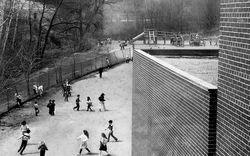articles
The planet is the client
autonomous house, McGill University, Minimum Cost Housing Group (MCHG), Stop the Five Gallon Flush, toilets
19 October 2015
The planet is the client
articles
The planet is the client
articles
Glimpses of Nuclear Ontario
The planet is the client
21 November 2016
The planet is the client
Project
AP148.S1.1970.PR02
Description:
The project series documents Poli's work on the Interplanetary Architecture project, which was also made into a film by Superstudio directed by Alessandro Poli (the film is not included in the fonds). The project reflects Poli's deep fascination with the moon landing in 1969. Poli uses this major media event as a catalyst for thinking about a new approach to architecture and tools for design, including the idea that film and the movie camera should become part of the toolset. The project also seems to be in some way a response to Epoch magazine's challenge for a "Primo concorso di architettura nello spazio" (the first architectural competition in space), and includes much imagery and textual references to a new road or architectural links between the earth and other planets, including an earth moon highway. In his storyboard, Poli also makes reference to his earlier Piper project, and some imagery features wheels and an amusement park. The Interplanetary Architecture project was exhibited by Superstudio in Rome in 1972 and featured in "Casabella" magazine in April 1972 (no. 364). The project was also featured in the 2010 CCA exhibition "Other Space Odysseys". In the accompanying CCA publication, Poli describes this project as "a voyage off earthbound routes in quest of architecture unfettered by the urban nightmare, by induced needs or by planning as the only tool for regulating and solving the world's problems" (Poli quoted in Borasi and Zardini, 2010, 110). Poli's work on this project is deeply tied to the Zeno project, which was also featured in this exhibition and is included in this fonds (see AP148.S1.1972.PR01). For the Zeno project, Poli envisioned a dialogue between astronaut Buzz Aldrin and an Italian peasant, Zeno of Riparbella. Poli felt that these two shared a similarity in that both their homes were isolated capsules, one that provided a lens from which to see the rest of the world and understand their place in it. The material in the series includes numerous photomontages and collages of astronauts in space, as well as drawings of plantery shapes and structures. There are also texts, some of which include calculations of distances and diameters of planets, as well as notebooks and sketchbooks, many of which Poli included in a folder he entitled "Storyboard." The series also includes an unsent letter from Poli to Adolfo Natalini which describes how, after the moon landing, everything - the planet, the moon, the stars - is architecture, and that this will necessitate the need for new design tools, such as the movie camera. Some works are signed Alessandro Poli-Superstudio. Source cited: Giovanna Borasi and Mirko Zardini, eds., Other Space Odysseys, Montreal and Baden: Canadian Centre for Architecture/Lars Müller Publishers, 2010.
1969-1971
Architettura Interplanetaria [Interplanetary Architecture] (1970-1971)
Actions:
AP148.S1.1970.PR02
Description:
The project series documents Poli's work on the Interplanetary Architecture project, which was also made into a film by Superstudio directed by Alessandro Poli (the film is not included in the fonds). The project reflects Poli's deep fascination with the moon landing in 1969. Poli uses this major media event as a catalyst for thinking about a new approach to architecture and tools for design, including the idea that film and the movie camera should become part of the toolset. The project also seems to be in some way a response to Epoch magazine's challenge for a "Primo concorso di architettura nello spazio" (the first architectural competition in space), and includes much imagery and textual references to a new road or architectural links between the earth and other planets, including an earth moon highway. In his storyboard, Poli also makes reference to his earlier Piper project, and some imagery features wheels and an amusement park. The Interplanetary Architecture project was exhibited by Superstudio in Rome in 1972 and featured in "Casabella" magazine in April 1972 (no. 364). The project was also featured in the 2010 CCA exhibition "Other Space Odysseys". In the accompanying CCA publication, Poli describes this project as "a voyage off earthbound routes in quest of architecture unfettered by the urban nightmare, by induced needs or by planning as the only tool for regulating and solving the world's problems" (Poli quoted in Borasi and Zardini, 2010, 110). Poli's work on this project is deeply tied to the Zeno project, which was also featured in this exhibition and is included in this fonds (see AP148.S1.1972.PR01). For the Zeno project, Poli envisioned a dialogue between astronaut Buzz Aldrin and an Italian peasant, Zeno of Riparbella. Poli felt that these two shared a similarity in that both their homes were isolated capsules, one that provided a lens from which to see the rest of the world and understand their place in it. The material in the series includes numerous photomontages and collages of astronauts in space, as well as drawings of plantery shapes and structures. There are also texts, some of which include calculations of distances and diameters of planets, as well as notebooks and sketchbooks, many of which Poli included in a folder he entitled "Storyboard." The series also includes an unsent letter from Poli to Adolfo Natalini which describes how, after the moon landing, everything - the planet, the moon, the stars - is architecture, and that this will necessitate the need for new design tools, such as the movie camera. Some works are signed Alessandro Poli-Superstudio. Source cited: Giovanna Borasi and Mirko Zardini, eds., Other Space Odysseys, Montreal and Baden: Canadian Centre for Architecture/Lars Müller Publishers, 2010.
Project
1969-1971
Project
AP207.S1.2013.PR01
Description:
The project series documents "The Game of Architecture", a drawing realized in 2013. The drawing is of triangular-shaped structures made of bricks standing in a desert. This drawing is a reinterpretation of a previous project by Pettena "Situazioni Competitive" in 1971. "Here architecture, albeit with the same characteristic of competitiveness, becomes indistinct, confused, no longer the leading actor, at the mercy of an unknown context (a desert? the nature of an alien planet?) which, threatening to overwhelm it, seems to nullify its every need and characteristic." [1] The project series contains a drawing for the 2013 edition and the 2018 version, which is a digital photograph modified to show the architectural construction standing in rough water. Source: [1] Gianni Pettena website, https://www.giannipettena.it/italiano/opere-1/nat-the-game-of-architecture-2013-1/ (last accessed 28 January 2020)
2011-2018
The Game of Architecture (2013)
Actions:
AP207.S1.2013.PR01
Description:
The project series documents "The Game of Architecture", a drawing realized in 2013. The drawing is of triangular-shaped structures made of bricks standing in a desert. This drawing is a reinterpretation of a previous project by Pettena "Situazioni Competitive" in 1971. "Here architecture, albeit with the same characteristic of competitiveness, becomes indistinct, confused, no longer the leading actor, at the mercy of an unknown context (a desert? the nature of an alien planet?) which, threatening to overwhelm it, seems to nullify its every need and characteristic." [1] The project series contains a drawing for the 2013 edition and the 2018 version, which is a digital photograph modified to show the architectural construction standing in rough water. Source: [1] Gianni Pettena website, https://www.giannipettena.it/italiano/opere-1/nat-the-game-of-architecture-2013-1/ (last accessed 28 January 2020)
Project
2011-2018
books
Description:
381 pages ; 21 cm.
Paris : Seuil, ©1980.
La planète des bidonvilles : perspectives de l'explosion urbaine dans le Tiers monde / Bernard Granotier.
Actions:
Holdings:
Description:
381 pages ; 21 cm.
books
Paris : Seuil, ©1980.
books
Description:
191 pages : illustrations, map, plans, portraits ; 29 cm.
Paris : Textuel ; Genève : Zoé, [2005]
Le Corbusier, la planète comme chantier / Jean-Louis Cohen.
Actions:
Holdings:
Description:
191 pages : illustrations, map, plans, portraits ; 29 cm.
books
Paris : Textuel ; Genève : Zoé, [2005]
books
Description:
243 pages : illustrations ; 22 cm
Montréal : Éditions Écosociété, ©2007.
Écodesign, des solutions pour la planète : l'aventure du New Alchemy Institute / Nancy Jack Todd ; traduit de l'anglais par Françoise Forest.
Actions:
Holdings:
Description:
243 pages : illustrations ; 22 cm
books
Montréal : Éditions Écosociété, ©2007.
books
Description:
189 pages.
Paris : Rue de l'échiquier, 2010.
Les transports, la planète et le citoyen : en finir avec la galère, découvrir la mobilité durable / Ludovic Bu, Marc Fontanès, Olivier Razemon.
Actions:
Holdings:
Description:
189 pages.
books
Paris : Rue de l'échiquier, 2010.
books
Description:
167 pages
Moisenay : Gaud, 2006.
Les jardins de Valloires : De la planète à la planète / textes de Sonia Lesot ; photographies de Henri Gaud.
Actions:
Holdings:
Description:
167 pages
books
Moisenay : Gaud, 2006.


